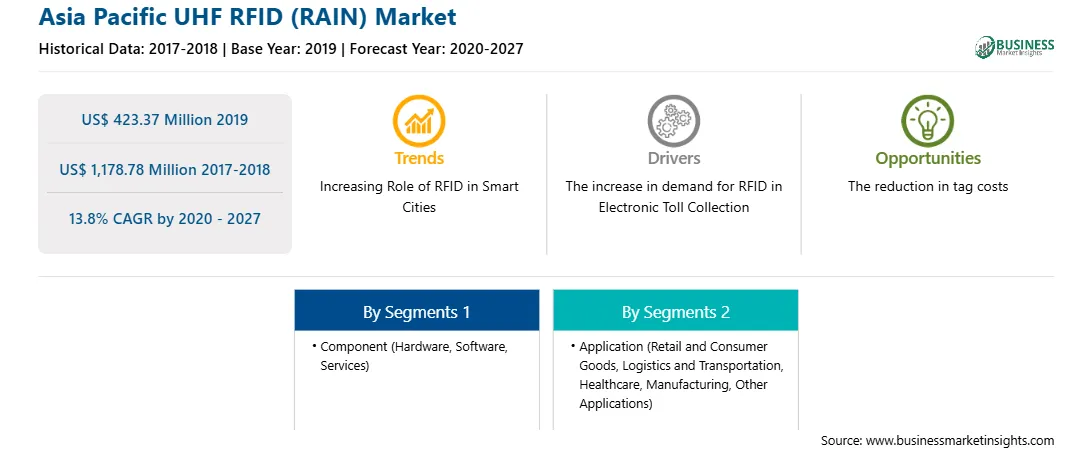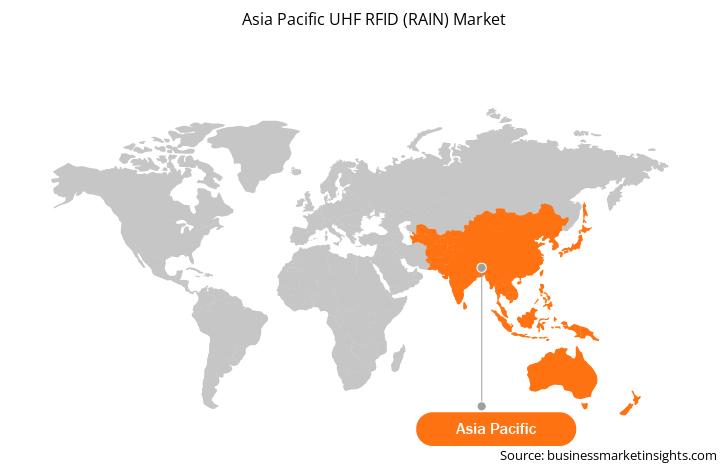The presence of emerging economies and the growing adoption of advanced and sophisticated technologies are contributing to the overall growth of APAC. Australia, China, Japan, and India are the main contributors to the UHF RDIF (RAIN) market in this region. Rapid developments in technologies, digitalization of economies, and adequate support from governments are contributing to the smooth evolution of these economies from the developing stage to the developed stage.
Rising investments by Asian, as well as international retailers present in the region, to offer a seamless experience to customers is propelling the adoption of hardware and software solutions across the retail sector. These solutions assist in better management of operations such as inventory management and product tracking. The retail sector also forms a major part of the developing economies. For instance, according to studies by India Brand Equity Foundation—an initiative of the Ministry of Commerce & Industry, Government of India—the retail sector of India contributes ~10% to the country’s gross domestic product (GDP) every year. Asia homes the two largely populated countries of the world—China and India. Moreover, youth accounts for a large share of their huge populations. The young population is highly attracted toward supermarkets and hypermarkets for buying essentials as well luxurious products. Thus, it becomes important for the retail sector to handle their products and operations efficiently to cater to their requirements and live up to their expectations. These factors are expected to influence the adoption of UHF RFID (RAIN) tags and labels across the retail sector in APAC in the coming years. Also, new opportunities being created due to developments in IoT is a major factor driving the APAC UHF RFID (RAIN) market.
APAC is characterized by many developing countries, a positive economic outlook, high industrial presence, huge population, and rising disposable income. All these factors make APAC a major growth driving region for various markets, including UHF RFID (RAIN). Many online shoppers and the growing e-commerce sector in this region present a huge opportunity for the growth of the global UHF RFID (RAIN) market. Due to the pandemic, social distancing and staying home have pushed the consumers towards online shopping. Nevertheless, uncertain consumer demand and supply chain problems have affected the UHF RFID (RAIN) industry in the region. The e-commerce supply chains are mainly strained by the pandemic and factory closures in China. The lockdown of various factories in China affects the global supply chains and negatively impacts manufacturing, delivery schedules, and various products and services. Even as the factories in China are beginning to reopen, several logistics businesses have reduced or hit pause on their operations; thus, some cargo terminals shut down due to low volume. China has impacted adversely in the automotive industry. The country is the world’s largest car market, and Wuhan city is home to various auto plants, such as Honda, General Motors, Nissan, and Renault. As per the World Economic Forum (WEF), for Honda Company alone, the city holds ~50% of total production in China. In 2019, in China, Hubei Province was the fourth-largest car manufacturer, with ~10% of China’s car-making capacity and manufactured 2.24 million vehicles. However, several auto companies closed their doors as part of the nationwide shutdown. Hence, it resulted in a decline in car and its spare part sales. The restrictions imposed on human movement in APAC countries to control the spread of COVID-19 have negatively impacted the retail business, especially the businesses of hypermarkets, supermarket, and specialty stores.

Strategic insights for the Asia Pacific UHF RFID (RAIN) provides data-driven analysis of the industry landscape, including current trends, key players, and regional nuances. These insights offer actionable recommendations, enabling readers to differentiate themselves from competitors by identifying untapped segments or developing unique value propositions. Leveraging data analytics, these insights help industry players anticipate the market shifts, whether investors, manufacturers, or other stakeholders. A future-oriented perspective is essential, helping stakeholders anticipate market shifts and position themselves for long-term success in this dynamic region. Ultimately, effective strategic insights empower readers to make informed decisions that drive profitability and achieve their business objectives within the market.

| Report Attribute | Details |
|---|---|
| Market size in 2019 | US$ 423.37 Million |
| Market Size by 2027 | US$ 1,178.78 Million |
| Global CAGR (2020 - 2027) | 13.8% |
| Historical Data | 2017-2018 |
| Forecast period | 2020-2027 |
| Segments Covered |
By Component
|
| Regions and Countries Covered | Asia-Pacific
|
| Market leaders and key company profiles |
The geographic scope of the Asia Pacific UHF RFID (RAIN) refers to the specific areas in which a business operates and competes. Understanding local distinctions, such as diverse consumer preferences (e.g., demand for specific plug types or battery backup durations), varying economic conditions, and regulatory environments, is crucial for tailoring strategies to specific markets. Businesses can expand their reach by identifying underserved areas or adapting their offerings to meet local demands. A clear market focus allows for more effective resource allocation, targeted marketing campaigns, and better positioning against local competitors, ultimately driving growth in those targeted areas.

The UHF RFID (RAIN) market in APAC is expected to grow from US$ 423.37 million in 2019 to US$ 1,178.78 million by 2027; it is estimated to grow at a CAGR of 13.8% from 2020 to 2027. Continuous developments in inventory tracking technologies are driving the growth of the retail sector at an unprecedented rate. The sector boosts the reach of numerous businesses to customers, thereby providing them necessary exposure. The growing emphasis on online marketing tools, such as Facebook and Google ads, has been contributing to the boom in the retail sector. In the retail sector, the Radio Frequency Identification (RFID) is hugely adopted for apparel tagging. The apparel vendors are progressively leveraging digitalization and Big Data analytics with the help of RFID applications. RFID is a mature technology that uses radio waves to transmit data from RFID tags to a reader, which helps identify objects based on the caught data or track the location of the same. Several retail sector giants, such as H&M, Lululemon, Zara, and Nike, use UHF RFID technology for inventory management, which helps them generate a more effective supply chain, combat counterfeit items, and prevent out-of-stock situations.
The APAC UHF RFID (RAIN) market is segmented into component, and application. Based on component, the market is segmented into hardware and software and services. The hardware segment held the largest share of APAC UHF RFID (RAIN) market in 2019. The UHF RFID (RAIN) market, based on application, is segmented into retail and consumer goods, logistics and transportation, healthcare, manufacturing, and other applications. The market for the retail and consumer goods segment held the largest share of APAC UHF RFID (RAIN) market in 2019.
A few major primary and secondary sources referred to for preparing this report on the UHF RFID (RAIN) market in APAC are company websites, annual reports, financial reports, national government documents, and statistical database, among others. Major companies listed in the report are CAEN RFID S.r.l; Convergence Systems Limited; Impinj, Inc.; Invengo Technology Pte. Ltd.; Jadak- A Novanta Company; Murata Manufacturing Co., Ltd.; NXP Semiconductors N.V.; Securitag Assembly Group Co., LTD (SAG); Walki Group Oy.
The List of Companies - Asia Pacific UHF RFID (RAIN) Market
The Asia Pacific UHF RFID (RAIN) Market is valued at US$ 423.37 Million in 2019, it is projected to reach US$ 1,178.78 Million by 2027.
As per our report Asia Pacific UHF RFID (RAIN) Market, the market size is valued at US$ 423.37 Million in 2019, projecting it to reach US$ 1,178.78 Million by 2027. This translates to a CAGR of approximately 13.8% during the forecast period.
The Asia Pacific UHF RFID (RAIN) Market report typically cover these key segments-
The historic period, base year, and forecast period can vary slightly depending on the specific market research report. However, for the Asia Pacific UHF RFID (RAIN) Market report:
The Asia Pacific UHF RFID (RAIN) Market is populated by several key players, each contributing to its growth and innovation. Some of the major players include:
The Asia Pacific UHF RFID (RAIN) Market report is valuable for diverse stakeholders, including:
Essentially, anyone involved in or considering involvement in the Asia Pacific UHF RFID (RAIN) Market value chain can benefit from the information contained in a comprehensive market report.